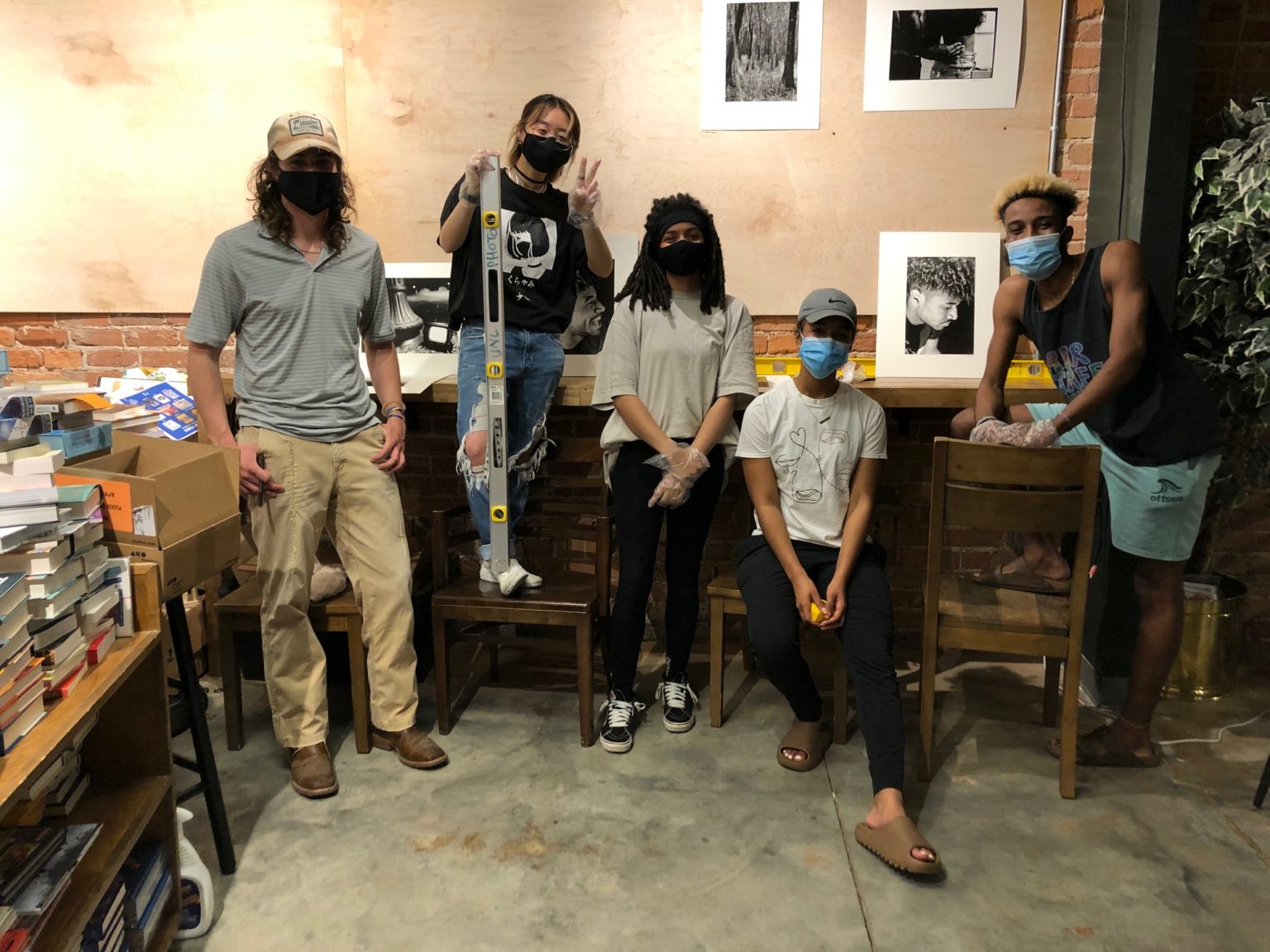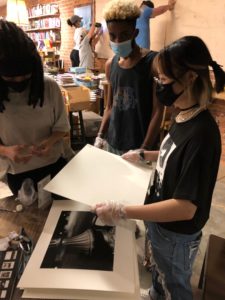Via the Orange County Arts Commission, Article by Brian Howe

UNC-Chapel Hill photography students install exhibit “Figuring the Local,” on display through May 14th at Epilogue Books
Modestly sized, matted but unframed, and mounted on plain, honest wooden boards, the pictures flow in a sinuous grid along Epilogue’s crumbly brick walls. Taken one by one, they tell the stories that five photography students at UNC-Chapel Hill sought to sear onto black-and-white film and coax out in the darkroom, on topics such as the sea-to-table ecosystem, the multiplicity of the Black male experience and the emotional texture of dreams.
Taken together, as their overall pattern of heavy dark, snowy bright and human interplay in space almost demands, these portraits, landscapes and details tell other stories, too—about the pandemic, personal authenticity and the darkroom’s resilience in the digital age.
The exhibit, “Figuring The Local,” is on view through May 14 at the Chapel Hill bookstore and café, which specializes in local chocolate, coffee and beer. Supported by the Beatrice B. Pearman Undergraduate Research Fund in Art, it draws together the semester-long individual projects of Jack Boucher, Paris Hackett, Julie Sun, Joshua Walker, and Davia Webb, undergraduates in Gesche Würfel’s advanced darkroom photography course.
“I think students find the darkroom inspiring because you have to be very focused,” Gesche says. “Film is expensive, you have limited exposures, and you have to be very selective.” Students have told her that, after the darkroom class, they looked at things differently when composing digital photos.
Davia Webb, a senior from Goldsboro who is majoring in studio art and art history, used the form of the self-portrait to explore the effects of isolation in lockdown. In postures that flicker between expressing self-care and anxiety, Davia fills the frames, evoking the feeling of being alone in a room for so long that you almost become the room.
“COVID definitely brought out something new for me,” Davia says in a class Zoom meeting. “[The project] is about how I interact and don’t interact with the world, and the changes I saw in my own mental state, how fear and paranoia manifested. It definitely got me out of my comfort zone, because I normally would never do a project with myself as the subject.”
The solitude of one in Davia’s photos becomes the solitude of two in those of Paris Hackett, a junior from Charlotte who is majoring in studio art and journalism, and whose photos feature incisively cropped gestures from the interior worlds of couples.
“My photos were exploring the dynamics of intimacy, of couples in relationships who’ve been quarantined for a long time,” says Paris, who is also minoring in African and African American diaspora studies. “The camera changes the dynamic of the environment, so that was new for me, to explore how the camera comes into relationship with the people.”
The models are people Paris knows. “I focus more on what’s personal to me rather than modeling, because I like to represent things correctly, in a sense,” she explains.
Authentic representation was also the concern of Joshua Walker, a junior from Durham studying history and public policy with a studio art minor. He also used models he knows, intimately participating in candid moments of emotion, joy and vulnerability.
“I talked to them throughout the shoot, asking semi-personal questions, funny questions, capturing their genuine reactions,” Joshua says. “I tried to capture them as they are—the true reality of certain Black men and how it’s not a monolithic experience. We’re all very unique: We’re sad, we’re happy, we have a good time, we chill, we do all these different things. I wanted to capture who we are outside of the continual racial issues that are all we really see in the media.”
Julie Sun, a junior from Charlottesville, Virginia who is studying photography and law, did a digital fashion photography shoot for her main project but created “Static Dreamscapes” in the darkroom specifically for the exhibit, providing an experimental counterpoint for the more naturalistic images. A small, glowing television poses in incongruous landscapes like fields and street corners, evoking classical surrealism in the manner of Man Ray.
“This was more of a dreamscape” than her usual work, Julie says, “like the mental images we make when we’re dreaming. I usually do portrait photography, but I also do a lot of narrative photography, and this plays into that role. Storytelling is part of photography in my experience.”
From the high, soft mists of dreams, we come down to the hard salt flats of reality in the photos of Jack Boucher, a sophomore from Rocky Mount who is majoring in geology. A nature and fishing photographer, Jack, inspired by his love of the beach and a discussion in another class of how much water it takes to produce a pound of beef, turned his interest to industry.
“Both the commercial and tourism side of it have a huge impact,” he says. “North Carolina is a seafood hotspot around the country, especially oysters, and I wanted to show people all the steps between the ocean and their plates, and how much energy and effort it takes.”
It’s common to hear older folks talk about the lasting power of analogue photography, but there’s something inspiring about hearing younger folks, all born in the digital age and fairly new to the darkroom, discovering that power for themselves.
“For the exhibition, we focused more on classical technique, but some people are working with scratching or chemically altering their negatives and things like that,” Davia says. “Outside of the camera, there’s a lot you can do in the darkroom to make your prints entirely different from the negative. I think it’s really fun, and I like the amount of freedom that we have.”
“I feel like the artform of photography is taken for granted because of how accessible it is,” Joshua adds. “It’s so easy that the process isn’t really a process anymore. I feel like darkroom made me slow down and appreciate the art more.”
“In a way, it’s taught me to be patient,” Paris concludes. “It’s different when you see your work immediately and can reshoot. With film, it’s like a waiting game. It’s either going to be really good or really disappointing. It’s more climactic in a sense for me.”

UNC-Chapel Hill photography students
 Chapelboro.com has partnered with the Orange County Arts Commission to bring more arts-focused content to our readers through columns written by local people about some of the fantastic things happening in our local arts scene! Since 1985, the OCAC has worked to to promote and strengthen the artistic and cultural development of Orange County, North Carolina.
Chapelboro.com has partnered with the Orange County Arts Commission to bring more arts-focused content to our readers through columns written by local people about some of the fantastic things happening in our local arts scene! Since 1985, the OCAC has worked to to promote and strengthen the artistic and cultural development of Orange County, North Carolina.


